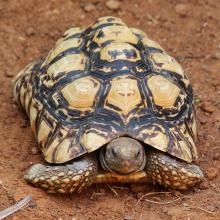
Characterized by a distinct leopard-like pattern on their shell, Leopard Tortoises have a remarkable shell that serves as protective armour. It is composed of bone covered by a layer of keratin. The tortoise is able to pull its head and legs inside this shell when threatened by predators.
Their diet consists of various plant materials including leaves, flowers, fruits, thistles, and parts of succulents. They have an excellent sense of smell, aiding them in locating food. They possess strong nails on their legs that enable them to climb hills and navigate different terrains to access their next meal.
Leopard Tortoises reach sexual maturity at around 12 to 15 years of age. During the breeding season, which occurs between May and October, the female digs a hole to lay a clutch of 5 to 30 eggs. Multiple clutches, usually 5 to 7, may be laid in a season. The incubation period lasts between 8 to 15 months, depending on the temperature. Eggs and hatchlings face numerous predators, such as monitor lizards, jackals, snakes, and crows. While generally slow-moving, they are capable of sprinting when they feel threatened.
Leopard Tortoises rely on external sources of heat to regulate their body temperature. They bask in the sun to raise their body temperature, and they can also retreat into underground burrows when the temperature is too hot.
These tortoises have a weight of around 13 kg and reach a length of approximately 40 cm. They can live up to 100 years.
